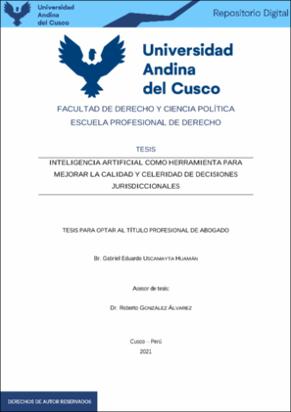| dc.contributor.advisor | González Álvarez, Roberto | |
| dc.contributor.author | Uscamayta Huamán, Gabriel Eduardo | |
| dc.date.accessioned | 2021-11-19T14:16:08Z | |
| dc.date.available | 2021-11-19T14:16:08Z | |
| dc.date.issued | 2021-08-31 | |
| dc.identifier.uri | https://hdl.handle.net/20.500.12557/4259 | |
| dc.description.abstract | La Inteligencia Artificial (IA) ha sido catalogada como disruptiva desde hace unos buenos
años. De hecho, hay quienes creen que esta será como la electricidad en un futuro no tan
lejano, es decir, que todo dependerá de ella. Pese a estos pronósticos, la situación actual de
la IA es aún modesta y se encuentra limitada al soporte y apoyo en distintas actividades
humanas. Una de ellas es el Derecho, y en especial, la ayuda en la decisión judicial.
El interés sobre la IA en el Derecho ha cobrado interés al encontrarse frente a situaciones
desalentadoras como la del servicio público de justicia, con grandes cargas de trabajo,
procedimientos inconclusos y justiciables insatisfechos. Frente a esta situación, la idea de
que tecnologías disruptivas como la IA pueden ayudar a superar algunos problemas, resulta
alentadora e invita a la reflexión.
Por todo ello, el presente trabajo aborda la pregunta ¿cómo es que la IA puede ayudar en la
mejora de calidad y celeridad de la toma de decisiones judiciales en el proceso civil
peruano? Para responder esta pregunta, primero analizamos cómo es que en Perú se mide la
calidad de las decisiones judiciales y que se entiende por esta. Paso seguido se analiza
teóricamente la postura adoptada por el ordenamiento peruano con respecto a la calidad,
para después identificar qué factores no permiten alcanzar esa calidad deseada.
Posteriormente, se plantea la pregunta si la IA puede ayudar a alcanzar ese parámetro de
calidad, analizándola y explicando sus orígenes y funciones. Finalmente, se emite un
diagnóstico de acuerdo a los sistemas de IA disponibles de cómo esta podría utilizarse para
mejorar la calidad y celeridad en la toma de decisiones jurisdiccionales, haciendo énfasis en
dominios específicos como la admisión de demandas o la segmentación de casos para darles
mayor prioridad a unos y menor prioridad a otros. Como punto adicional, se hace la
recomendación de sistemas eventuales con características específicas para ayudar en
determinadas labores jurisdiccionales y se adjunta un diseño teórico de un árbol de decisión
que permita emular el razonamiento por precedentes. | es_PE |
| dc.description.abstract | Artificial Intelligence (AI) has been catalogued as disruptive since its last advances. In fact,
there are those who believe that it will be like electricity in the not so distant future, that is,
that everything will depend on it. In spite of these forecasts, the situation of the AI today is
more modest and it is limited to the support and assistance in different human activities.
One of them is law, and especially, help in the judicial decision. A great enigma of this has
been the constant question of how to automate a judicial decision and if it is possible to do
so.
What is certain is that these questions have taken on greater importance when faced with
discouraging situations such as that of public justice service, with large workloads,
unfinished procedures and unsatisfied justiciables. Faced with this situation, the idea that
disruptive technologies such as AI can help overcome some problems is encouraging and
thought-provoking.
Therefore, this paper addresses the question of how AI can help in improving the quality
and speed of judicial decision making in the Peruvian civil process. To answer this question,
we first analyze how the quality of judicial decisions in Peru is measured and understood.
We then theoretically analyze the position taken by the Peruvian legal system with respect
to quality, and then identify which factors do not allow for the desired quality to be achieved.
The question then arises as to whether AI can help achieve that quality parameter by
analyzing it and explaining its origins and functions. Finally, a diagnosis is made according
to the available AI systems of how it could be used to improve the quality and speed of
jurisdictional decision-making, emphasizing specific domains such as the admission of
claims or the segmentation of cases to give greater priority to some and lesser priority to
others. As an additional point, we recommend eventual systems with specific characteristics
to help in certain jurisdictional tasks. | en_US |
| dc.format | application/pdf | es_PE |
| dc.language.iso | spa | es_PE |
| dc.publisher | Universidad Andina del Cusco | es_PE |
| dc.rights | info:eu-repo/semantics/openAccess | es_PE |
| dc.rights.uri | https://creativecommons.org/licenses/by-nc-nd/4.0/ | es_PE |
| dc.subject | Calidad de decisiones judiciales | es_PE |
| dc.subject | Celeridad de decisiones judiciales | es_PE |
| dc.subject | Automatización de admisión de demandas | es_PE |
| dc.subject | Segmentación de casos por prioridades | es_PE |
| dc.title | Inteligencia artificial como herramienta para mejorar la calidad y celeridad de decisiones jurisdiccionales | es_PE |
| dc.type | info:eu-repo/semantics/bachelorThesis | es_PE |
| thesis.degree.name | Abogado | es_PE |
| thesis.degree.grantor | Universidad Andina del Cusco. Facultad de Derecho y Ciencia Política | es_PE |
| thesis.degree.discipline | Derecho | es_PE |
| dc.publisher.country | PE | es_PE |
| dc.subject.ocde | https://purl.org/pe-repo/ocde/ford#5.05.01 | es_PE |
| renati.advisor.dni | 23864455 | |
| renati.advisor.orcid | https://orcid.org/0000-0001-9782-6228 | es_PE |
| renati.author.dni | 70399912 | |
| renati.discipline | 421016 | es_PE |
| renati.juror | Diaz Torres, José Hildebrando | |
| renati.juror | Vargas Castro, Ignacio Bladimiro | |
| renati.juror | Alvarez Trujillo, María Antonieta | |
| renati.juror | Mercado Espejo, Ivonne | |
| renati.level | https://purl.org/pe-repo/renati/level#tituloProfesional | es_PE |
| renati.type | https://purl.org/pe-repo/renati/type#tesis | es_PE |


